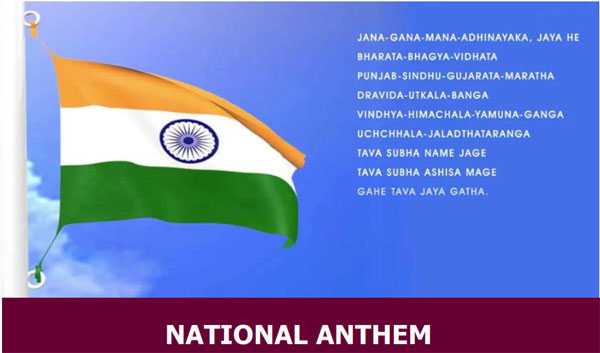NEW! The Gist (APR-24) | E-BOOKS |
NATIONAL ANTHEM :Civil Services Mentor Magazine: MAY - 2017
::NATIONAL ANTHEM::
The Indian National Anthem represents the hopes and aspirations
of the people of India. It is the symbol of our national pride. Jana Gana Mana
was first written in Bengali, the first of five stanzas of the Brahmo hymn
titled
Bharot Bhagyo Bidhata are attributed to Rabindranath Tagore. The underlying
message of Jana Gana Mana is pluralism. Its Hindi version was adopted by the
Constituent Assembly as the National Anthem of India on 1950. Though the Bengali
song had been written in 1911, it was largely unknown except to the readers of
Tattwabodhini Patrika.
According to British press National anthem was composed in December 1911, coinciding with the visit of King George V at the time of the Coronation Durbar of George V, and "Bharat Bhagya Bidhata" and "Adhinayaka" was believed to be in praise of King George V.The poem is created in 'shankarabharana' rag.The composition was first sung during a convention of the then loyalist Indian National Congress in Calcutta on 27 December 1911. It was sung on the second day of the convention, and the agenda of that day devoted itself to a loyal welcome of George V on his visit to India.
A formal rendition of the national anthem takes approximately fifty-two seconds. A shortened version consisting of the first and last lines (and taking about 20 seconds to play) is also staged occasionally. India's Constitution speaks of respect to the national flag and anthem as a fundamental duty in Part 1V A. Article 51(A) says that "it shall be the duty of every citizen of India - (a) to abide by the Constitution and respect the ideals of the national flag and the national anthem".
Legal Provisions
Apart from the constitutional provisions related to national
anthem, various acts also provides the limitations and compulsions on performing
the national anthem. Under prevention of Insults to National Honour Act of 1971
whoever burns, mutilates, destroys, disfigures or otherwise shows disrespect to
India's National Flag shall be punished with max imprisonment of 3 yrs. Also
Under the same Act whoever intentionally prevents the singing of National Anthem
or causes any disturbance in such singing can be punished with imprisonment of 3
yrs. Disrespect to national insignia has been linked to Section 124(A) of IPC,
which refers to sedition. SC in recent judgment said national anthem should be
played before the start of movie and audience should stand in attention ,
however exception has been given to specially abled persons. However in Bijoe
Emmanuel & Ors vs State Of Kerala & Ors, granted protection to three children of
the Jehovah's Witness sect, who didn't join in the singing of the national
anthem at their school. The court held that forcing the children to sing the
anthem violated their fundamental right to religion. Also in In 1943, the US
Supreme Court delivered a 6-3 opinion, holding that the Free Speech Clause of
the First Amendment to the US Constitution protected students from being forced
to salute the American flag.
Way to perform
The National Anthem of India is played or sung on various
occasions. Instructions have been issued from time to time about the correct
versions of the Anthem, the occasions on which these are to be played or sung,
and about the need for paying respect to the anthem by observance of proper
decorum on such occasions. The substance of these instructions has been embodied
in the information sheet issued by the government of India for general
information and guidance. The approximate duration of the National Anthem of
India is 52 seconds.
-
There are two versions of the National anthem fullversion takes 52 sec to perform, while the short version takes around 20 seconds.
-
Full version shall be played at Civil and Military investitures, during parade, On arrival of the President at formal State functions etc
-
The short version of the Anthem shall be played when drinking toasts in Messes.
-
Whenever the Anthem is sung or played, the audience shall stand to attention.


